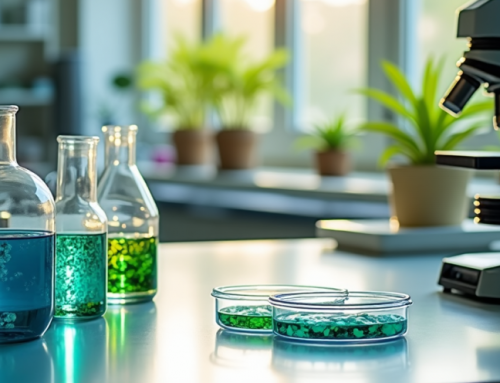Updated for the new IB Chemistry Internal Assessment requirements starting May 2025.
This guide will walk you through each section of your Chemistry IA, showing you how to meet the IB criteria with confidence while also keeping your report clear, well-structured, and engaging.
1. Introduction
Your introduction should be concise—roughly half a page to one page long—and give the reader a clear idea of what your investigation is about.
Here’s what to include:
- A short overview of the topic and its relevance. For instance, what chemical substance are you analysing? What is its real-world application?
- State the personal or broader significance of the topic. Why did you choose this? How is it important globally or scientifically?
- Briefly mention the experimental technique you’ll use (e.g. titration, colourimetry, pH measurement) and justify why it’s suitable for your research question.
Tip: Keep this section focused—avoid going into excessive background detail yet.
2. Research Question
Your research question should be specific, measurable, and clearly framed in terms of independent and dependent variables.
Include:
- The full research question written as a question.
- The units for both variables.
- A description of how the dependent variable will be measured (name the method/instrument used).
- If the independent variable doesn’t have units (e.g. comparing brands or categories), clearly list the groups or labels being compared.
Example format:
To what extent does the time spinach is boiled (1–5 minutes) affect its vitamin C content (mg), as determined by iodometric titration?
3. Background Information
This is where you show your understanding of the chemistry behind your investigation.
Include:
- A description of the chemical structure and properties of the substance you’re studying (e.g. polarity, functional groups, stability).
- An explanation of how these properties make the molecule suitable for the method used.
- Information on any relevant reagents (e.g. iodine in titrations, solvents in extractions) and why they are appropriate.
- Any relevant chemical equations, including balanced reaction equations.
- Diagrams or graphs (e.g. Maxwell-Boltzmann distribution, Arrhenius plots) with proper captions and source citations.
- In-text citations throughout.
Reminder: Keep everything directly relevant to your research question. Don’t drift into general or unrelated topics.
- Variables
This section must clearly define all variables in your experiment.
Include:
- Independent variable: with units and justification for the chosen range (e.g. why 0.1–0.5 M was selected instead of 0.1–2.0 M).
- Dependent variable: including units, how it will be measured, and instrument uncertainty.
- A table of controlled variables: explain how each variable is kept constant and why control is necessary.
5. Equipment List
List every piece of equipment and chemical you’ll be using.
Make sure to:
- Include uncertainties for measuring instruments (e.g. ±0.01 g for a balance).
- Provide concentrations or pH values of all standard solutions.
- Optionally, include a labelled diagram of your setup here (or place it in the method section).
6. Method
Your method should describe the steps taken in the lab in a logical and detailed manner.
Use the following approach:
- Write in the third person (avoid “I” or “we”).
- Number the steps clearly or write in paragraph form using imperative tone.
- Keep descriptions precise enough that someone else could replicate your experiment.
At the end, include a risk assessment table covering:
- Safety concerns (e.g. handling corrosive chemicals)
- Ethical issues (e.g. animal testing – if applicable)
- Environmental considerations (e.g. disposal of chemicals)
7. Results
This is the section where you present your processed data (not raw data).
Include:
- Tables with clear headings, captions, and units. Use consistent significant figures.
- Qualitative observations (e.g. colour changes, bubbling) in a separate table.
- Sample calculations: show one example of each type (averages, concentration, molarity).
- Uncertainty propagation: include one full worked example and summarise the rest in a table.
- Graphs: plot the dependent vs independent variable with full labelling, error bars if appropriate, and include an R² value for linear graphs.
- A short paragraph interpreting the graph (e.g. trend direction, correlation strength).
8. Conclusion
Your conclusion should summarise your findings and revisit the research question.
Include:
- A restatement of your aim.
- A summary of trends in the data, using specific values (e.g. “As temperature rose from 25°C to 60°C, the reaction rate doubled from 4.2 cm³/s to 8.5 cm³/s”).
- A discussion of the extent to which your results answered the research question.
- Comment on the reliability of the results, including a reflection on uncertainties and how they affect confidence in the data.
- Literature value comparisons, where possible, with citations.
9. Evaluation
This is your chance to demonstrate critical thinking about your experiment.
Include:
- A short paragraph on the strengths of your investigation.
- A table of weaknesses: for each, explain the source of error, its impact on the results, and how it could be improved.
- A reflection on random, systematic, and human errors and how they could be minimised in future.
- Extensions: suggest follow-up experiments or ideas for how the study could be taken further (e.g. testing additional compounds, changing one of the controlled variables).
10. References
End with a complete bibliography of all sources cited throughout the IA.
- Use the same referencing style consistently (e.g. APA, MLA).
- Ensure every in-text citation has a corresponding full reference.
Final Tips
- Keep your IA under 3,000 words, excluding tables, diagrams, calculations, and references.
- Maintain a scientific tone throughout—avoid overly casual or narrative language.
- Use subheadings to organise your IA clearly for the examiner.
If you’d like to see some high-scoring Chemistry IAs for inspiration—or if you want personalised feedback on your draft—contact us to learn more. We’re here to help you succeed.






Leave A Comment